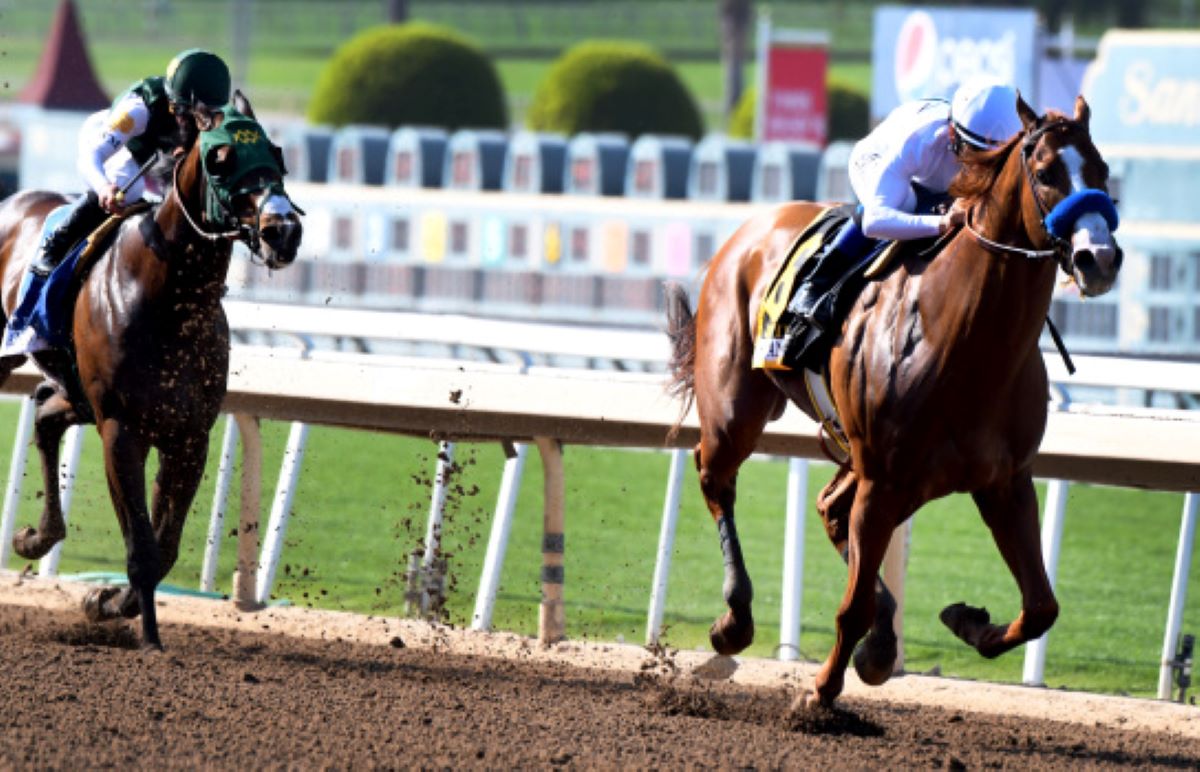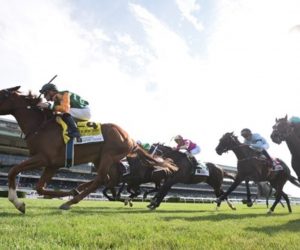By this point in his lengthy career in horse racing, which covers everything from steward to TV personality, Jon White’s skin is as tough as leather. He understands that most of you don’t understand what goes into making a racing morning line.

But the saying, “Everyone’s a critic†means, well, White – who makes Santa Anita Park’s morning line — is fair game for everyone. Even those who know better.
Like Bob Baffert.
The Hall of Fame trainer took issue with White making his horse, Justify, the morning line favorite for the 2018 Santa Anita Derby. To Baffert, Bolt d’Oro should be the favorite. After all, the Mick Ruis-trained colt was more experienced than Baffert’s lightly raced Justify.
White didn’t blink. He made Justify the 4/5 morning line favorite, tacking 6/5 odds on Bolt d’Oro. When Justify won, springboarding himself to an eventual Triple Crown, White was vindicated yet again.
Even White Bakes in the Baffert Factor
“My feeling is if I’m going to be wrong, I’d rather be wrong making a Baffert horse the favorite instead of a Ruis horse the favorite,†White said. “It was a tough decision one way or another, but if I’m going to turn out wrong, if I’m going to make Bolt the favorite, people are going to ask me ‘How can you not make an undefeated Baffert horse the favorite?’ The percentages are an undefeated Bob Baffert horse will be the favorite. I think I was right about that. It’s important for me to have the right one and I did. Sometimes, you’re right and sometimes you’re wrong.â€
“Sometimes, you’re right and sometimes you’re wrong.†With those seven words, White speaks for himself and every morning-line maker in the world. Santa Anita’s morning line author since 2009, and the author of six Breeders’ Cup morning lines, White spent an afternoon explaining to OG News what goes into constructing a morning line.
“That’s one of the misunderstood aspects of what I do,†he said. “I’m not setting odds as to how the race will turn out. I’m setting odds in trying to predict how the public will bet the race.â€
‘Morning Line’ Became a Misnomer
The misunderstood aspects of White’s job start there. They segue into the name. When White started making morning lines for small, now-gone tracks in the Pacific Northwest in the late 1970s, then for the Los Angeles Times in the 1980s, writers made morning lines the morning of a race. That allowed for more accurate lines, since if you’re making lines Sunday morning for a Sunday afternoon card, you’ve got far more information at your disposal.
Then, because of track demands regarding the printing of programs, morning-line deadlines were pushed back to the morning before. Now, because of the Daily Racing Form, White needs to get his lines in two days before. The DRF pushed the early date to fit printing schedules for its print version.
“We no longer make a morning line. It’s an advance line,†White said. “It’s a shame we couldn’t get that changed because we could give people a more accurate perception.â€
Since except for holiday weekends, Santa Anita runs a three-day, Friday-Sunday card, White begins working on Friday’s line the previous Sunday. He has to finish Friday’s line by Wednesday morning. That’s when scratches are due to the racing office.
White Calls Upon Every Scrap of Information
White spends between six and eight hours constructing a typical morning line. If you think handicapping a certain race is mind-bending, put yourself in White’s brain. He starts by establishing a tentative favorite. Then, he goes through past performances and workouts of every horse in every race since their last race, monitoring distances – if a horse cuts back for this race or goes longer – weather, sales price, and key races. Those are races where at least two other horses came out and won their next start.
Every factor about every horse comes into play. For Santa Anita’s Saturday, Dec. 26 opening-day, 11-race card, White got the past performances at 2:30 p.m. Monday afternoon. He worked on that card for 11 hours, taking only a half-hour for lunch, and finishing by 10:30 the next morning.
Before he starts, White examines longtime Southern California handicappers, such as former Los Angeles Times and Los Angeles Herald-Examiner race writer Bob Mieszerski and DRF handicappers Brad Free and Michael Hammersly. He does this to both validate his opinion and see if he’s out on an island with a given horse.
For his Breeders’ Cup lines, White spends time on Oddschecker, evaluating the European horses coming over for the various turf races. All the while, he must factor in European horses will be shorter priced there than in the US.
Morning Lines Come Via A Points System
As for the line itself, White uses a general formula employed by line makers. He assigns odds using a point system factoring in the track takeout. Each line number is given a corresponding point number. For example, a horse at 1/2 gets 66 points. A horse at even-money gets 50 points. A horse at 3/1 gets 25 points, while a 30/1 horse gets three points.
Factoring in takeout, scratches, and other variables, White targets 127 or 128 points for each race. That means if he has an odds-on favorite, the other horses in the field will have higher odds to balance the line. This explains why in a 12-horse race, you won’t see a short-priced horse.
Morning Line Odds Chart
| Odds | Points/Betting Percentages |
| 1/9 | 90 |
| 1/5 | 83 |
| 2/5 | 71 |
| 1/2 | 66 |
| 3/5 | 62 |
| 4/5 | 55 |
| Even | 50 |
| 6/5 | 45 |
| 7/5 | 41 |
| 8/5 | 38 |
| 9/5 | 35 |
| 2/1 | 33 |
| 5/2 | 28 |
| 3/1 | 25 |
| 7/2 | 22 |
| 4/1 | 20 |
| 9/2 | 18 |
| 5/1 | 16 |
| 6/1 | 14 |
| 8/1 | 11 |
| 10/1 | 9 |
| 12/1 | 7 |
| 15/1 | 6 |
| 20/1 | 4 |
| 30/1 | 3 |
| 50/1 | 1 |
Because of those big fields, White will sometimes push his target up into the low 130s, which allows for the inevitable scratches. Those send White back to the drawing board, especially if a high-point horse scratches. Meanwhile, as he moves up the odds ladder, White plays a psychological game with bettors.
The Chosen Vron (8-5 morning-line favorite) has been scratched in Race 7 at Santa Anita Saturday, the California Cup Derby.
Revised morning line Race 7 Santa Anita Saturday: (2) 8-1 (3) 7-2 (4) 5-2 (5) 3-1 (6) 8-1 (7) 6-1 (8) 6-1 (9) 30-1
— Jon White (@PostTimeJon) January 16, 2021
“It’s single-digits vs. double-digit. There’s not a big difference between 8/1 and 10/1 in odds. It’s close in percentage: 11% (8/1) and 9% (10/1),†he said. “But if I make a horse 10/1 and he gets bet down to 4/1, it’s very noticeable. That horse looks like it was hammered. But if I make it 8/1 and it gets bet down to 3/1 or 4/1, it doesn’t look as bad.â€
Everything Stems From Establishing the Favorite
That’s not White’s most important job. His primary goal, aside from predicting how the public will bet the race, is nailing who the favorite will be once the gates open. White learned a long time ago it all starts there.
Nashville is the 6-5 morning-line favorite in Saturday's G1 RUNHAPPY Malibu Stakes on opening day at Santa Anita. Charlatan is the 9-5 second choice in the field of 6. Independence Hall is 4-1. Collusion Illusion & Thousand Words are each 8-1. Express Train is 15-1.
— Jon White (@PostTimeJon) December 22, 2020
“My most important role is to be as accurate as possible in forecasting the favorite,†he said. “When you listen to those guys on the radio or TVG or NBC or Fox, what they’re looking at when they handicap is who is the favorite? Most people are trying to beat the favorite to get value. The more often I’m right, the more confident they are in terms of handicapping ahead of time. And if I’m not right, it will hurt handle. Nowadays, there are so many tracks you can bet on your computer. If you can’t handicap a race ahead of time, you’re going to find a track where you can handicap it.â€
White is accurate a striking amount of the time. Through Jan. 10, White’s morning line favorites went off as the actual favorite 77.3% of the time. Since he took over the morning line in 2009, White has never dropped below 70%. He took over Del Mar’s Bing Crosby Meet last fall and hit 72.5% of the favorites. That represented a 20% increase over his predecessor.
That 11-race, opening-day card? The one White spent 11 hours writing? He went 11-for-11.
White’s Experience Crosses the Sport’s Spectrum
“I’m proud of that fact because with computer bettors driving money into pools late, that can affect who will be the favorite,†he said. “The more competitive and the larger the fields, the harder it is. It’s very hard to sweep an entire program.â€
White’s enjoyed a nearly 50-plus year love affair with the sport. He’s been to 65 different tracks. At 24, he was the youngest licensed steward in the history of Washington State. He was the first on-air personality HRTV hired before TVG acquired that network. He worked for the DRF and as the media relations director at Lone Star Park.

And yet, White lives for the day-to-day grind of writing morning lines. Playing Tetris with the pieces, making them fit, and having the public prove him right is its own reward.
“The challenge. I feel like, for instance, each card at Santa Anita is eight, nine, 10 tests and you’re preparing the best you can for the test with all the work you put into it,†he said. “Not how the race turns out, but how the betting turns out. How the race turns out was gratifying to me in that I helped some people in the public by what I did. For the morning line, I would say it’s like the challenge of handicapping, but you’re not just handicapping the horses. You’re handicapping the bettors, and that in itself is its own interesting challenge.â€











